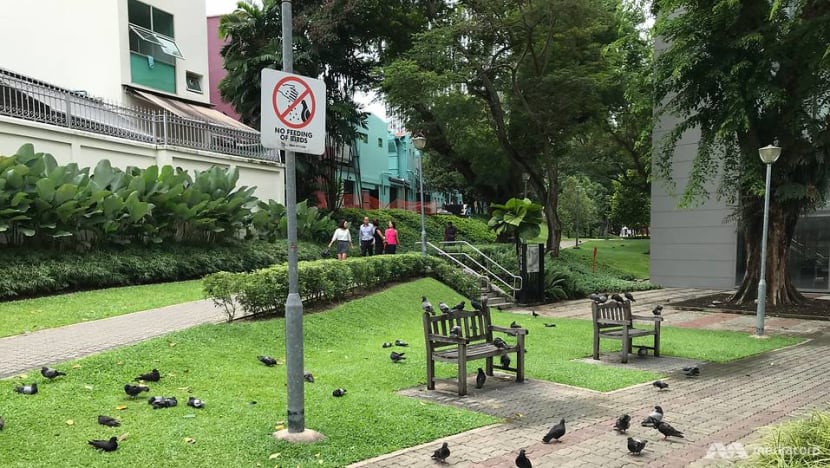CNA Explains: Singapore has a pigeon problem. What’s being done about it?
What risks do these birds pose, and just how effective is culling?

A group of pigeons at Duxton Plain Park in Singapore. (Photo: Low Zoey)

This audio is generated by an AI tool.
SINGAPORE: Three town council estates in Singapore with large clusters of pigeons will be stepping up culling efforts over the next six months, among other measures such as reducing human food sources.
Why does Singapore need to reduce the pigeon population?
Authorities say this is for public health reasons.
Pigeons carry diseases such as salmonella bacteria, which causes diarrhoea, fever and stomach pain. Their droppings can spread the ornithosis disease, which results in fever, headache, vomiting and muscle aches among other symptoms.
There haven't been any confirmed cases of people in Singapore getting sick from pigeons.
But the birds are seen as a nuisance because of their messy feeding and droppings, said the Bird Society of Singapore's president Keita Sin.
Their droppings can soil public areas, stain clothing and bother diners at open-air eateries.
Don't other birds pose the same problems?
Singapore is also home to other bird species - some invasive - such as mynahs, crows, koels and wild chickens.
Like pigeons, Javan mynahs - the small black birds with yellow beaks - can cause hygiene issues.
In 2018, several residents in the Potong Pasir area also complained about the noise made by mynahs. It led to the birds being trapped and culled.
House crows, meanwhile, are commonly found in cities, towns and urban settings. When they gather and roost near residential areas, their cawing and accumulated droppings can be a nuisance too
Last year, after several people were attacked by crows in Bishan, the National Parks Board (NParks) removed their nests and trapped and culled the birds.
Another bird that's hard to miss is the Asian koel - perhaps better known as the "uwu" bird. But unlike the rest, they're considered a native species protected under the Wild Animals and Birds Act.
Koels actually help to control the crow population by laying their eggs in crows' nests and removing crow eggs in the process. But they can also be disruptive with their loud, repetitive and high-pitched mating calls.
NParks has thus had to remove crow nests to manage the Asian koel population.
Compounding the issue is the fact that pigeons and the other birds also have few natural predators in Singapore.
Back in 2011, there were reports of businesses along the Orchard Road shopping belt planning to deploy a trained hawk to scare off mynahs. A trial run failed when the large raptor wound up intimidated by the flocks of smaller birds instead.
Does culling really work?
Not on its own, according to authorities and animal welfare groups.
Culling is only done in Singapore as a last resort and might work as a temporary measure.
But it needs to be combined with other steps - such as reducing food sources - to be an effective, long-term solution, said Bird Society of Singapore's Mr Sin.
American non-profit animal rights organisation People for the Ethical Treatment of Animals or PETA has said that putting down adult pigeons is "unsatisfactory and ineffective".
When adult pigeons are removed, younger birds have less competition for food and end up reproducing at a faster rate.
Culling aside, NParks also carries out other bird management methods such as habitat modification, which involves the pruning of trees. The aim is to deter birds such as crows and mynahs from settling on the trees, and to break up large roosts.
Is it possible to effectively reduce food sources then?
Efforts can be made to manage refuse and food waste at bin centres and food establishments, but another problem persists in the form of illegal bird feeding.
Residents and organisations such as Nature Society Singapore and Animal Concerns Research and Education Society (ACRES) have called for more enforcement against the act, which can lead to a fine of up to S$10,000 (US$7,400).
Last year, NParks recorded 142 cases of enforcement action against pigeon feeding, compared with 140 in 2022 and 131 in 2021, the board's group director for wildlife management How Choon Beng said on Friday (Jun 28) in response to CNA's queries.
NParks has said it will monitor feedback on illegal bird feeding and take "active" steps including through physical surveillance and deploying closed-circuit television cameras.
But questions remain on whether such measures actually deter feeders. Much has been said about education, and an NParks spokesperson previously told CNA the key lies in understanding the motivations behind such behaviour.
To discourage bird feeding, NParks may offer some feeders alternative activities such as community gardening and birdwatching, said Mr How.
He added that those with mental health needs will be linked up with community care organisations for counselling or other forms of support.
Daily Cuts - Managing Singapore's pigeon population without culling?
Can people coexist peacefully with birds and wildlife in Singapore?
Besides pigeons or birds in general, the occasional encounter with other wildlife such as monkeys, wild boars and even crocodiles has made headlines over the years.
Some of these animals have had to be killed for the safety of residents.
But there are other ways to prevent human-wildlife conflict, experts have said.
One such measure is to set up safe "corridors" for wildlife so they don't come into man-made areas such roads and residential estates, ACRES co-CEO Anbarasi Boopal previously told CNA.
Not feeding animals is an important step on its own, the Bird Society of Singapore’s Mr Sin reiterated.
While feeding may be done out of kindness and concern, it can lead to undesirable consequences.
For one, an abundance of food sources will cause wildlife to breed faster, which can increase the population size. Their natural habitat may not be enough to support them, causing them to venture even more into urban spaces.
Not to mention human food potentially even making animals sick.
In the words of NParks: "Not feeding is caring".



















